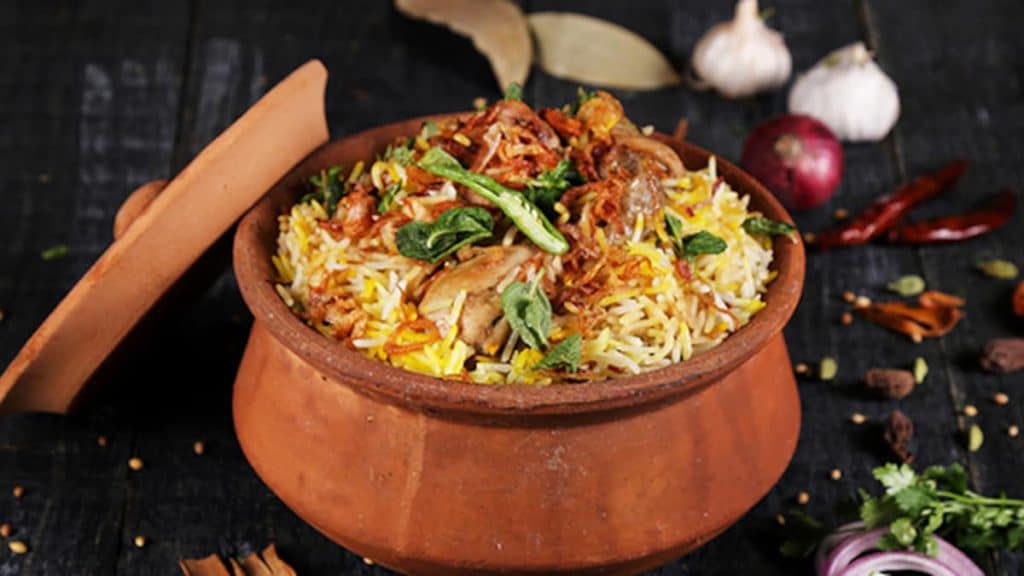A veg biryani as the name suggests is a biryani without any meat in it. It is cooked with vegetables, basmati rice or any other rice (read more about Rice Nutrition), herbs and spices. It is a great option for people who are vegetarians but want to experience the taste of biryani. A veg biryani recipe may differ from person to person in what rice, spices and herbs they use. If you are confused and want to know how to make veg biryani, then don’t worry this article will help you with an easy veg biryani recipe.
About Veg Biryani Recipe
Veg biryani recipe typically contains 200 calories per serving, with carbohydrates accounting for the majority of the calories. This dish also contains a lot of fiber, vitamins, and minerals. However, because of the spices and condiments, their sodium content is relatively high. Those who want to maintain a healthy weight should limit their portions and avoid adding extra fats like ghee or oil. Easy Veg Biryani Recipe is an excellent choice for vegetarians seeking a flavorful and spicy dish.
An easy veg biryani recipe with Zero-oil has a number of noticeable health advantages, including higher immune function, lower triglyceride levels, increased stamina, and healthy weight loss.
Veg Biryani recipe with vegetables will keep you young and fit for a long time and is actually very healthy, but when oil, ghee, or dahl are added, it becomes extremely unhealthy. Read on to know how to make veg biryani healthy and delicious.
| Time | Difficulty | Serves |
| 35 min | Moderate | 2 |
How to Make Instant Veg Biryani at Home (Step-by-Step)
Learn how to make Veg Biryani recipe through these easy steps:-
Step 1: Boil the rice and keep them aside
Step 2: In a pan, add the spices and cook well. Then, add the tomato puree. Make sure it doesn’t burn.
Step 3: Once cooked, add the rice and 1 cup of water to your pan and combine well. Let it cook on low flame.
Step 4: When the biryani is halfway done, add the vegetables and let them cook with the biryani.
Step 5: Add in Dahi or low-fat curd and let it cook on low flame. Garnish well and serve with Raita and salad.
Preparation for Veg Biryani Recipe
Make sure to do your prep work beforehand to avoid a last-minute hassle in making the Veg Biryani Recipe.
- Assemble all the components: Make sure you have all the materials you’ll need, including rice, vegetables, spices, ghee, and any additional optional components you wish to use, for making veg biryani. Before you begin cooking, double-check your recipe to be sure you have everything you need.
- Rice should be soaked: It’s a good idea to soak basmati rice, which is frequently used in biryani, in water for around 60 minutes before cooking. The rice benefits from soaking by cooking more evenly and staying from getting too sticky. Drain it before using the soaked rice in the Veg Biryani Recipe.
Ingredients for Veg Biryani Recipe
Here’s what you need to make the Veg Biryani recipe
- Organic rice, soaked in water for about an hour.
- 2–3 cloves
- 2 small cinnamon sticks
- Tomato sauce
- 12 cups curd
- 4 potatoes, boiled
- boiled carrots, finely chopped (Read more about Carrot Nutrition)
- 1 cup fresh green peas (boiled)
- Cumin seed powder
- Chili powder, red
- Sliced onions (Read more about Onion Nutrition)
- Powdered turmeric
- The bay leaves
Method/Steps to Cook Veg Biryani
Follow these detailed steps to make the best and easy Veg Biryani recipe at home:-
Step 1: Boil the rice in the same manner as you would regular rice. When the rice is done, set it aside.
Step 2: Warm up a nonstick frying pan. Once your pan is hot, add the cloves, cinnamon, and bay leaves. Cook until the bay leaves and other masalas are light brown.
Step 3: Now add your spices, which should include turmeric powder, red chili powder, and cumin powder. Saute it for a few minutes before adding the tomato puree.
Step 4: Continue to roast it and make sure it doesn’t burn; if it sticks to the pan, add some water. Make sure all of your spices are well-roasted without burning.
Step 5: Now, add rice to your pan and thoroughly combine it. Add about a cup of water.
Step 6: When your biryani is halfway done, add the vegetables. Allow the vegetables to cook for a few minutes. Add low-fat curd or dahi and season with salt to taste.
Step 7: Reduce the heat and leave it to cook for a while.
Step 8: To make the biryani look more appealing, garnish it with salad or raitha. Your 100% vegetarian biryani with no oil is now ready to serve.
Any Alternate Way To Make Veg Biryani
People often wonder how to make veg biryani recipe in an easy fashion. Here, we’ll tell you an easy way to make the most Indian cuisine.
Step 1: Basmati rice should be well-rinsed in cold water until the water is clear. After 30 minutes of soaking, strain the rice.
Step 2: Bring 4 cups of water to a boil in a big pot. Salt, bay leaf, cloves, cardamom pods, and cinnamon stick should be added. Basmati rice should be added to the pot and cooked until it is 70% done. After draining, set the rice aside.
Step 3: Ghee or vegetable oil should be heated over medium heat in a separate pot. Fennel and cumin seeds are added, and they are fried for one minute.
Step 4: Sliced onions should be added to the stew and cooked until golden brown.
Step 5: After one minute, add the ginger-garlic paste.
Step 6: To the pot, add the chopped tomatoes, biryani masala, turmeric, red chili, and black pepper. Cook the spices thoroughly and the tomatoes until they are tender.
Step 7: Cook the yogurt in the pot for an additional two to three minutes.
Step 8: The pot should now have mixed veggies, mint leaves and cilantro leaves. Let them cook for 2 to 3 minutes.
Step 9: Over the vegetable curry in the pot, spread the half-cooked rice. Rice should be topped with chopped cilantro leaves, soaking saffron and fried onions (if used).
Step 10: Cook the rice for 20 to 25 minutes on low heat, or until it is thoroughly cooked and the flavors are combined.
Nutritional Value in Veg Biryani
Here is the nutritional value of the Veg Biryani recipe (per one cup)
| Serving Size | Quantity per cup (169g) |
| Calories | 198 |
| Fat | 3.9g |
| Carbohydrates | 37g |
| Protein | 4.2g |
Pro Tips to Make the Best Veg Biryani at Home
Follow these tips to make the best Veg Biryani recipe at home:-
- Rice: To begin making a biryani, you’ll need good-quality basmati rice, preferably aged basmati rice. Biryani is not mushy, and the rice grains remain distinct in the dish. I used aged basmati rice in this recipe.
- Sella Basmati Rice: I also make biryani with parboiled basmati rice (also known as sella basmati rice in Hindi and converted basmati rice outside of India), and it works just as well as aged basmati rice. Biryani made with sella basmati rice has restaurant-style flavors, as this rice is used in many hotels and restaurants in India to make biryani as well as other rice-based dishes such as pulao, fried rice, and jeera rice (cumin rice).
- Rice cooking: The rice grains are boiled until they are 34 cooked. They will be slightly undercooked and have a slight bite to them. If you overcook the rice, it will become mushy by the time the biryani is dum-cooked.
- Spices: Using whole spices gives a biryani its lovely fragrance and aroma. As a result, the spices must be fresh and in good condition.
- Curd (yogurt): Because the vegetable curry is made with yogurt, it is critical that the yogurt be fresh and not sour. Whole milk should also be used to make the curd or yogurt. Fat-free yogurt or curd made from toned milk should not be used because it will split while cooking.
- Biryani gravy: The vegetarian biryani curry or gravy should be medium- to medium-thick in consistency. It should not be watery like stock or broth, as this will result in mushy or very soft rice after dum cooking.
- Vegan version: Use cashew milk yogurt or almond milk yogurt. Oil can be used in place of ghee (Read more about Ghee Nutrition). You could use any vegetable oil or oil with a neutral flavor.
Health Benefits of Veg Biryani
There are a number of health benefits in the Veg Biryani Recipe. Some of these are mentioned below:-
- Vegetable biryani is laden with a variety of vegetables that are high in nutritional fiber, vitamins, and minerals. The various vegetables used in biryani, like carrots, peas, beans, cauliflower, and potatoes, offer a variety of minerals, including potassium, fiber, vitamin C, vitamin A, and vitamin K, all of which are crucial for maintaining general health and wellbeing.
- Numerous spices used in biryani, including cardamom, fennel seeds, cinnamon, and cloves, are well-known for their antioxidant effects. By scavenging dangerous free radicals in the body, antioxidants lessen oxidative stress and lower the likelihood of developing chronic illnesses like cancer and heart disease.
- Compared to other forms of biryani, vegetable biryani can be made with only little amounts of oil or ghee (clarified butter). For people watching their fat intake or attempting to maintain a healthy weight, this may be advantageous.
- The basmati rice used in biryani is a good source of dietary fiber, which helps regulate bowel motions and aids with digestion. Additionally, the mixed veggies in vegetable biryani add to the dish’s overall fiber level, aiding digestive health and intestinal health.
Tips to Limit the Calorie in Veg Biryani
Follow these tips to control the calories in your veg biryani recipe:-
- Use Whole Grains: Choose whole grains like brown rice, quinoa, or bulgur wheat over white rice. Because they include more fibre and minerals than refined grains, whole grains can help you feel fuller for longer and consume fewer calories overall.
- Control Portion Sizes: Pay attention to how much rice and other components in your biryani are served in each serving. Utilize smaller dishes and bowls, and be aware of your hunger cues, to prevent overeating.
- Use Less Oil or Ghee: The traditional preparation of biryani calls for sautéing rice, veggies, and spices in oil or ghee. Use little to no oil or ghee, and think about switching to healthier fats like coconut or olive oil. Cooking spray can also be used in place of oil.
Other than these tips, if you read more about how to make veg biryani healthy, you can ace a healthy and easy veg biryani recipe.
Types of Veg Biryani
Veg biryani recipe just like its non-veg counterpart comes in many varieties, some of which are mentioned below.
- Tomato Biryani – For people who love the taste of tomatoes, this veg biryani recipe is not only healthy but also delicious
- Paneer Biryani – Figuring out how to make veg biryani with paneer? A lot of people enjoy eating paneer with rice, to them, this veg biryani recipe will make them experience the authentic flavors of biryani.
- Mushroom Biryani – Who would have thought a veg biryani can have mushrooms in it? This is an easy veg biryani recipe with traditional flavors.
How to make Veg Biryani quickly?
Here’s how to make veg biryani quickly:-
First, prepare the rice.
Wash the Basmati rice under cold water. After 30 minutes of soaking, strain the rice.
Bring water to a boil in a big pot, then season with salt. Rice should be cooked until it is 70–80% done after being soaked, drained, and added to boiling water. After draining, set the rice aside.
Then, sauté the vegetables
In the same saucepan, heat the ghee or oil. Stir in the cumin seeds and cook for one minute.Add green chilies and onion slices. Onions should be sautéed till golden brown.
Tomatoes, mixed veggies, turmeric, red chile, and garam masala powder should all be added. Cook for 2 to 3 minutes. Add Yogurt, mint leaves and cilantro and stir thoroughly.
Layer the Biryani
Top the vegetable mixture in the pot with the half-cooked rice. Over the rice, drizzle some ghee or oil.
Once the rice is entirely cooked and the flavors have blended, cover the pot with a tight-fitting lid and cook on low heat for 15-20 minutes.
Serve and enjoy!
After the biryani has finished cooking, turn off the heat and allow it to sit for five minutes. Use a fork to gently fluff the rice, then serve it hot with raita or another side dish of your choice.
How to make Veg Biryani in a microwave?
Follow these steps to make Veg Biryani in a microwave:-
- Basmati rice should be well-rinsed in cold water until the water is clear. Put enough water in the rice to soak it for 30 minutes. After draining the water, set the rice aside.
- Ghee should be placed in a microwave-safe bowl and heated on high for 30 seconds or until melted. 30 more seconds in the microwave after adding the cumin seeds.
- To the bowl, add the chopped onions. Microwave on high for 2 to 3 minutes, or until transparent. Add the ginger-garlic paste and cook for an additional minute in the microwave.
- Add salt, Biryani masala powder, turmeric powder, red chilli powder, and chopped tomatoes to the bowl. Mix thoroughly and cook the vegetables in the microwave for 3 to 4 minutes, depending on their size.
- Mix the yogurt in the bowl thoroughly and cook for one minute in a microwave.
- Fill the bowl with the drained and soaked basmati rice. Mix slowly.
- Add 1.5 cups of water, then cook the rice on high for 8 to 10 minutes, or until it is tender and the water has been absorbed. To ensure consistent cooking, gently stir every few minutes.
- Pour the saffron-infused milk over the finished Biryani when the rice has finished cooking. The bowl can be snugly wrapped in microwave-safe plastic wrap or covered with a microwave-safe lid.
- Cook for 3–4 minutes on high in the microwave or until the flavors have combined and the Biryani is piping hot.
- Give the veg biryani some time to rest. Garnish Mint leaves and cilantro. Serve hot alongside the yogurt-based raita
FAQs
What’s different in the Veg Biryani Recipe by Livofy?
Different recipes for Veg Biryani can vary in their ingredients, cooking techniques, and flavor profiles. For example, Livofy’s Veg Biryani recipe may use a specific blend of spices or different vegetables than another recipe. They may also suggest a different cooking method or technique to achieve a particular texture or flavor.
Therefore, it’s essential to choose a recipe that suits your preferences, skill level, and dietary requirements. You can experiment with different Veg Biryani recipes and adapt them to your liking by adjusting the spice level or using different vegetables or protein sources. You can also try different recipes to know how to make veg biryani healthy and flavorful.
What is the cooking time for Veg Biryani?
It takes approximately 35-40 minutes to cook veg biryani.
Is Veg Biryani healthy?
Veg biryani can be a nutritious dish if it is made and eaten properly. The popular Indian rice dish called “Biryani” is composed of rice, vegetables, whole grains, and reasonable amounts of good fats, it can be healthful and balanced.
What is the right time to have Veg Biryani?
Eating biryani for dinner is preferred by most people.
Are there any side effects of eating Veg Biryani?
There are no prominent side effects of eating Veg Biryani, if eaten in moderation. However, having Biryani in excess may result in weight gain. It might as well make you feel bloated or fatigued if eaten every day.
How many calories does Veg Biryani have?
The Veg Biryani made out of 1 cup of rice has about 198 calories.
What kind of rice is used in biryani?
Basmati rice is used to make traditional Hyderabadi vegetable biryani. This rice is thinner and longer in length than regular rice. I prefer the brands Daawat Traditional Basmati Rice and Tilda Legendary Rice Pure Original Basmati.
Can you make this veg biryani vegan?
Yes, of course! Simply replace the ghee with vegetable oil, the dairy yogurt with almond milk yogurt and coconut milk yogurt, and the saffron infusion with non-dairy milk.
How to make Veg Biryani without onion and garlic?
Here’s how to make Veg Biryani without onion and Garlic:-
Step 1: Wash and soak the basmati rice for 30 minutes and then drain.
Step 2: In a pot, add the rice along with 2 cups of water , cinnamon, cloves and salt to taste. Cook the rice until it is 70% done and then rest aside
Step 3: In another pan, add cumin, green chillies and cook well. Add the vegetables (excluding onions) and cook well. Then add all your spices and cook for another minute.
Step 4: In it, add plain yogurt and salt to taste, Cook it together for 3-4 minutes.
Step 5: Now start with layering your biryani with partially cooked rice and vegetable masala.
Step 6: Drizzle saffron-infused milk and ghee on top. Cover the lid let it sit for 20 minutes.
Step 7: Serve hot with Raita on the side
 Livofy (formerly Keto India) Seen On Shark Tank!
Livofy (formerly Keto India) Seen On Shark Tank! 








